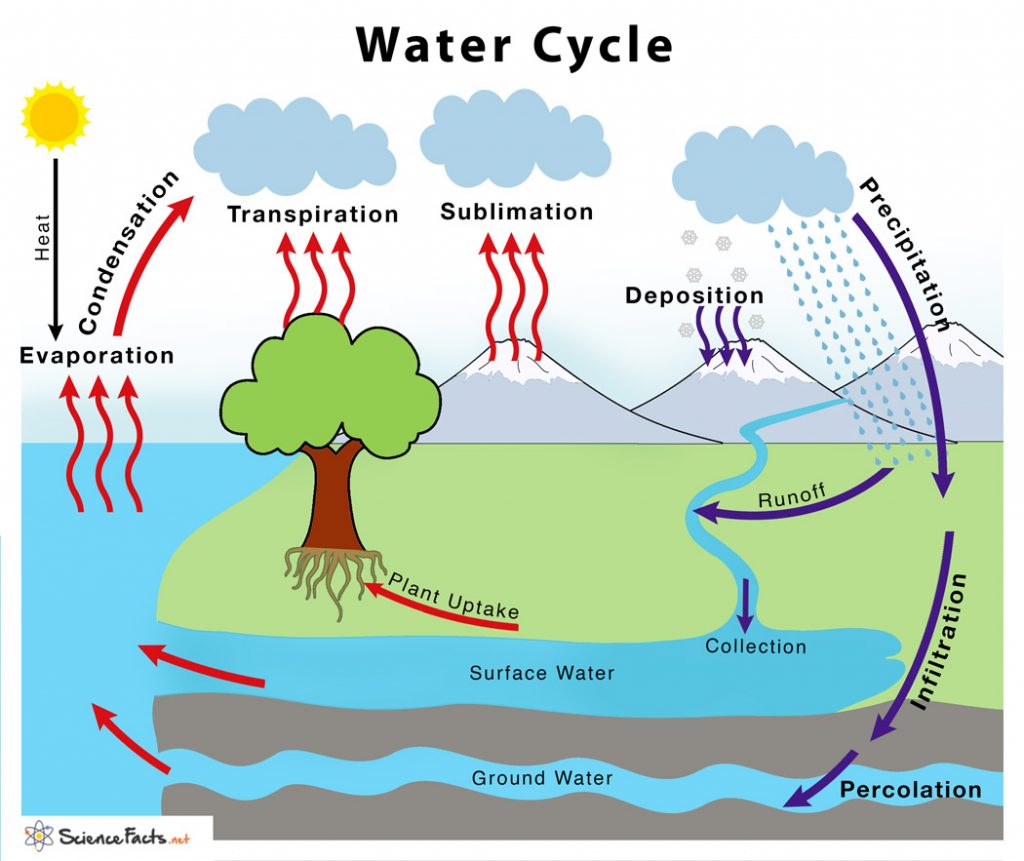The heat of the sun causes water from the surface of water bodies such as oceans, streams, and lakes to evaporate into water vapor in the atmosphere. Plants also contribute to the water cycle when water gets evaporated from the aerial parts of the plant, such as leaves and stems by the process of transpiration. 2. Change from Solid to Gaseous Phase – Sublimation Due to dry winds, low humidity, and low air pressure, snow present on the mountains change directly into water vapor, bypassing the liquid phase by a process known as sublimation. 3. Change from Gaseous to Liquid Phase – Condensation The invisible water vapor formed through evaporation, transpiration, and sublimation rises through the atmosphere, while cool air rushes to take its place. This is the process of condensation that allows water vapor to transform back into liquid, which is then stored in the form of clouds. Sometimes, a sudden drop in atmospheric temperature helps the water vapors to condense into tiny droplets of water that remain suspended in the air. These suspended water droplets get mixed with bits of dust in the air, resulting in fog. 4. Change from Gaseous to Liquid and Solid Phase – Precipitation and Deposition Wind movements cause the water-laden clouds to collide and fall back on the earth’s surface through precipitation, simply known as rain. The water that evaporated in the first stage thus returns into different water bodies on the earth’s surface, including the ocean, rivers, ponds, and lakes. In regions with extremely cold climate with sub-zero temperatures, the water vapor changes directly into frost and snow bypassing the liquid phase, causing snowfall in high altitudes by a process known as the deposition. 5. Return of the water back into the underground reserve – Runoff, Infiltration, Percolation, and Collection The water that falls back on the earth’s surface moves between the layers of soil and rocks and is accumulated as the underground water reserves known as aquifers. This process is further assisted by earthquakes, which help the underground water to reach the mantle of the earth. Some amount of precipitated water flows down the sides of mountains and hills to reach the water bodies, which again evaporates into the atmosphere. During volcanic eruptions, the underground water returns to the surface of the earth, where it mixes with the surface water bodies in order to continue the cycle.
Video: Water Cycle Explained
Making fresh water available to plants and animals, including humans, by purifying the groundwater on earth. During the water cycle, the water evaporates, leaving behind all the sediments and other dust particles. Similarly, for the sustenance of marine life, the saline range of all salt water bodies is kept within a certain permissible limit through infiltration. Allowing even distribution of water on all surfaces of the earth. Water is temporarily stored as clouds in the atmosphere, whereas surface water bodies such as rivers and oceans, together with underground water, form the major permanent water reserves. Causing a cooling effect on earth due to evaporation of water from surface water bodies, which help to form clouds that eventually precipitate down in the form of rain. This way water cycle affects the weather and climate of the earth.Ensuring some other biogeochemical cycles, including those concerning oxygen and phosphorus, to continue in nature.Cleaning the atmosphere by taking-away dust particles, shoot, and bacteria, thus acting as a means to purify the air we breathe.
a) Deforestation: Plants play an important role in the water cycle by preventing soil erosion and thus helps to increase the groundwater level of the earth. Also, plants contribute by absorbing water from the soil, which is then released back to the atmosphere during transpiration. Deforestation adversely affects both the above processes, thus breaking the flow of the water cycle. b) Pollution: Burning of fossil fuels acts as the major source of air pollution releasing toxic gases into the atmosphere, leading to the formation of smog and acid rain. Water from farmlands run off to the nearest water bodies carrying chemicals such as insecticides and pesticides along with them, thus causing water pollution. The presence of excessive contaminants in the atmosphere and water bodies decreases the evaporation and condensation on earth, thus adversely affecting the water cycle.
